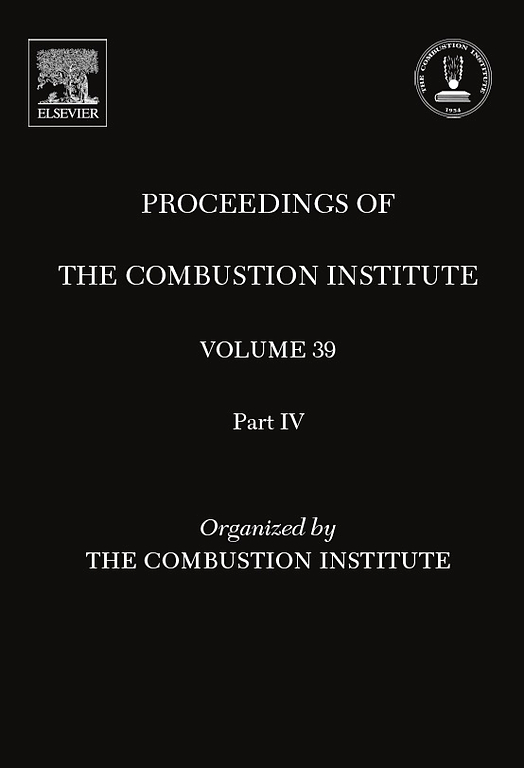Modelling collision frequencies and predicting bi-variate agglomerate size distributions for bi-disperse primary particle systems
IF 5.2
2区 工程技术
Q2 ENERGY & FUELS
引用次数: 0
Abstract
Agglomerate growth and the evolution of the agglomerate size distribution is determined by the collision frequencies between the agglomerates of the different size classes. For size distributions that can be parameterized by the agglomerates size only, expressions for the collision kernels exist and agglomerate growth can be predicted with sufficient accuracy. In the case of systems with polydisperse primary particles such as the agglomeration of soot or of systems with several components such as the flame synthesis of nanoparticles with taylor-made catalytic properties, a bi- or polydisperse size distribution is needed to account for the effects of the different primary particle sizes. In the present paper, collision frequency are obtained from a large series of Langevin dynamics (LD) simulations that are largely “model-free”. Bi-disperse primary particle systems are investigated where the size ratios of the primary particles are varied from unity to a factor of up to six. An analytic expression for an effective collision radius is suggested and accounts for functional dependencies on agglomerate size, composition and fractal dimension. Independent simulations for the evolution of the population balance equation (PBE) for the bi-variate agglomerate size distribution are conducted and assessed by comparison with corresponding Langevin dynamics simulations. The agreement between PBE solution and LD simulation results is generally very good indicating sufficient accuracy in modelling the collision kernel. Additional PBE simulation for mono-variate size distributions notably underpredict collision rates and errors of up to 140% in the total number of agglomerates can be expected by the end of a simulation for the larger size ratios. Errors are small for size ratios of two, but overall, a bi-variate parameterization of the population size distribution is needed to accurately predict agglomerate growth if the size ratio between the primary particles is notably larger than two.为双分散原生颗粒系统的碰撞频率建模并预测双变量团聚粒度分布
团聚体的增长和团聚体粒度分布的变化是由不同粒度等级的团聚体之间的碰撞频率决定的。对于仅可由团聚体大小确定参数的粒度分布,存在碰撞核的表达式,可以足够准确地预测团聚体的生长。对于具有多分散初级粒子的系统(如烟尘的团聚)或具有多种成分的系统(如具有泰勒催化特性的纳米粒子的火焰合成),需要使用双分散或多分散粒度分布来考虑不同初级粒子尺寸的影响。本文通过大量的朗格文动力学(LD)模拟获得了碰撞频率,这些模拟在很大程度上是 "无模型 "的。本文研究了双分散原生粒子系统,其中原生粒子的尺寸比从一到六倍不等。提出了有效碰撞半径的解析表达式,并考虑了与团聚体大小、组成和分形维度有关的功能依赖性。对双变量团聚体大小分布的种群平衡方程(PBE)的演变进行了独立模拟,并与相应的朗格文动力学模拟进行了比较评估。总体而言,PBE 解法与 LD 模拟结果之间的一致性非常好,表明碰撞核建模足够精确。针对单变量粒度分布进行的附加 PBE 模拟明显低估了碰撞率,对于较大的粒度比,预计模拟结束时团聚体总数的误差可达 140%。尺寸比为 2 时误差较小,但总体而言,如果原生粒子之间的尺寸比明显大于 2,则需要对群体尺寸分布进行双变量参数化,以准确预测团聚体的增长。
本文章由计算机程序翻译,如有差异,请以英文原文为准。
求助全文
约1分钟内获得全文
求助全文
来源期刊

Proceedings of the Combustion Institute
工程技术-工程:化工
CiteScore
7.00
自引率
0.00%
发文量
420
审稿时长
3.0 months
期刊介绍:
The Proceedings of the Combustion Institute contains forefront contributions in fundamentals and applications of combustion science. For more than 50 years, the Combustion Institute has served as the peak international society for dissemination of scientific and technical research in the combustion field. In addition to author submissions, the Proceedings of the Combustion Institute includes the Institute''s prestigious invited strategic and topical reviews that represent indispensable resources for emergent research in the field. All papers are subjected to rigorous peer review.
Research papers and invited topical reviews; Reaction Kinetics; Soot, PAH, and other large molecules; Diagnostics; Laminar Flames; Turbulent Flames; Heterogeneous Combustion; Spray and Droplet Combustion; Detonations, Explosions & Supersonic Combustion; Fire Research; Stationary Combustion Systems; IC Engine and Gas Turbine Combustion; New Technology Concepts
The electronic version of Proceedings of the Combustion Institute contains supplemental material such as reaction mechanisms, illustrating movies, and other data.
 求助内容:
求助内容: 应助结果提醒方式:
应助结果提醒方式:


